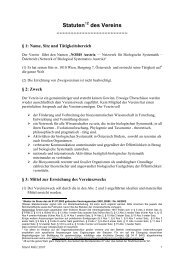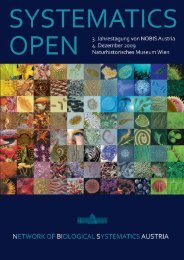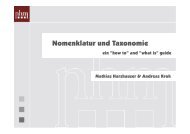4. Jahrestagung von NOBIS Austria 2. - 3. Dezember 2010
4. Jahrestagung von NOBIS Austria 2. - 3. Dezember 2010
4. Jahrestagung von NOBIS Austria 2. - 3. Dezember 2010
Create successful ePaper yourself
Turn your PDF publications into a flip-book with our unique Google optimized e-Paper software.
Increase of the corallum in the Silurian rugose coral Idiophyllum<br />
(Arachnophyllidae) from the Ningqiang Formation, China<br />
Kido, E. 1<br />
1 University of Graz, Institute for Earth Sciences (Geology & Paleontology), Heinrichstrasse 26, A-<br />
8010 Graz, e-mail: erikakido07@yahoo.co.jp<br />
Rugose corals are a fossil marine group which appeared in the middle Ordovician and became extinct<br />
end of Permian. Rugosa are identified based on the morphological features of their skeletal elements<br />
such as septa, tabulae, dissepiments, and wall, which are observed from serial transverse and<br />
longitudinal thin sections. The Silurian rugose coral Idiophyllum Cao occurs in the Ningqiang<br />
Formation (Upper Llandovery), Ningqiang-Guangyuan area near the border of Shaanxi and Sichuan,<br />
China. This coral occurs as both compound and solitary forms. Its corallum is characterized by<br />
possessing carinate septa displaying pinnate arrangement, convex tabularium which consists of<br />
incomplete tabulae, wide dissepimentarium, and distinct cardinal fossula. Idiophyllum has major, minor<br />
and tertiary septa. Tertiary septa are inserted irregularly and partly. The total number of septa in this<br />
coral reaches up to more than two hundred. Seven species have been assigned to Idiophyllum (He<br />
and Chen, 1986; Kido and Sugiyama, 2005); Idiophyllum dabashanense, I. multifurcatum, I.<br />
ningqiangense, I, tenuiseptatum, I. major, I. shaanxiense and I. massulatum. One of them, I.<br />
massulatum has a compound thamnasterioid corallum. He and Chen (1986) indicated that in the<br />
compound corallum of I. massulatum generally 2 to 5 offsets arise in the axial or peripheral region of<br />
the corallum of the parent. Lin et al. (1995) mentioned that the increase in the solitary corallum of<br />
Idiophyllum is parricidal. However, characteristics of the increase in corallum of Idiophyllum and septal<br />
insertion which is observed in the offsets have not been described in detail. Additional specimens of<br />
Idiophyllum massulatum and the species of Idiophyllum with solitary form were collected in the<br />
Ningqiang Formation of Yanzishi, Guangyuan, Sichuan. In these species peripheral and parricidal<br />
increase were observed, respectively. Modes of increase in Idiophyllum, together with the septal<br />
insertion observed in the offsets, are presented.<br />
He, X.Y. and Chen, J.Q. 1986. On the genus Idiophyllum. Acta Palaeontologica Sinica, 25(5), 525-530.<br />
Kido, E. and Sugiyama, T. 2005. Taxonomic comparison between Nanshanophyllum from Southwest Japan and<br />
Idiophyllum from Northwest China. Palaeontological Society of Japan, 46.<br />
Lin, B.Y., Xu, S.Y., Jia, H.Z. et al. 1987. Monograph of Palaeozoic corals, Rugosa and Heterocorallia. 788p,<br />
Geological Publishing House, Beijing.<br />
_____________________________________________________________________________<br />
24 Ber. Inst. Erdwiss. K.-F.-Univ. Graz, Band 15, <strong>2010</strong>; ISSN 1608-8166






